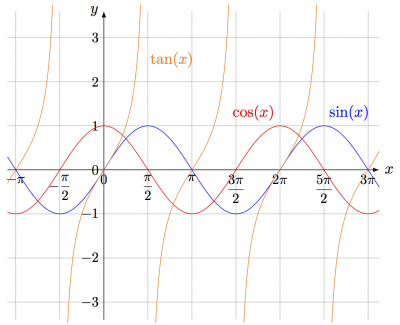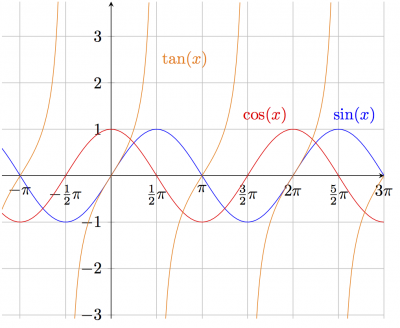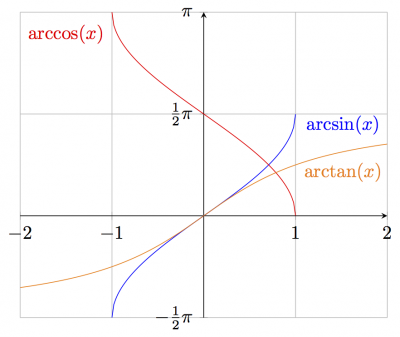User Tools
latex:tikz:functions
Example of plotting functions.
- functions.tex
% Author: Izaak Neutelings (June, 2017) % based on code from a friend \documentclass{article} \usepackage{amsmath} % for \dfrac \usepackage{tikz} \tikzset{>=latex} % for LaTeX arrow head \usepackage{pgfplots} % for the axis environment % split figures into pages \usepackage[active,tightpage]{preview} \PreviewEnvironment{tikzpicture} \setlength\PreviewBorder{1pt}% \begin{document} % DRAW PLOT: sin, cos, tan \begin{tikzpicture}[domain=-pi:pi,xscale=2/pi] % limits \def\xa{ -pi-0.3} \def\xb{3*pi+0.4} \def\ya{-3.4} \def\yb{ 3.6} \def\N{100} % number of points % axes & grid \draw[xstep=pi/2,very thin, color=gray] (\xa,\ya) grid (\xb,\yb); \draw[->] (\xa,0) -- (\xb,0) node[right] {$x$}; \draw[->] (0,\ya) -- (0,\yb) node[left] {$y$}; % ticks \draw[] % x node[below,scale=0.9] at ( -pi, 0) {$-\pi$} node[below,scale=0.9] at ( -pi/2, 0) {$-\dfrac{\pi}{2}$} node[below,scale=0.9] at ( pi, 0) {$\pi$} node[below,scale=0.9] at ( 0, 0) {0} node[below,scale=0.9] at ( pi/2, 0) {$\dfrac{\pi}{2}$} node[below,scale=0.9] at ( pi, 0) {$\pi$} node[below,scale=0.9] at (3*pi/2, 0) {$\dfrac{3\pi}{2}$} node[below,scale=0.9] at (2*pi, 0) {$2\pi$} node[below,scale=0.9] at (5*pi/2, 0) {$\dfrac{5\pi}{2}$} node[below,scale=0.9] at (3*pi, 0) {$3\pi$}; \draw[] % y node[left,scale=0.9] at ( 0, 3) {$3$} node[left,scale=0.9] at ( 0, 2) {$2$} node[left,scale=0.9] at ( 0, 1) {$1$} node[left,scale=0.9] at ( 0, 0) {$0$} node[left,scale=0.9] at ( 0, -1) {$-1$} node[left,scale=0.9] at ( 0, -2) {$-2$} node[left,scale=0.9] at ( 0, -3) {$-3$}; % functions \def\ea{0.28} \def\eb{0.26} \draw[color=blue,samples=\N,domain=\xa:\xb] % SIN plot(\x,{sin(\x r)}) % r for radians node[above right] at (5*pi/2,1) {$\sin(x)$}; \draw[color=red,samples=\N,domain=\xa:\xb] % COS plot(\x,{cos(\x r)}) node[above left] at (2*pi,1) {$\cos(x)$}; \draw[color=orange] % TAN plot[samples=\N,domain= \xa : -pi/2-\eb] (\x, {tan(\x r)}) plot[samples=\N,domain= -pi/2+\ea: pi/2-\eb] (\x, {tan(\x r)}) plot[samples=\N,domain= pi/2+\ea: 3*pi/2-\eb] (\x, {tan(\x r)}) plot[samples=\N,domain= 3*pi/2+\ea: 5*pi/2-\eb] (\x, {tan(\x r)}) plot[samples=\N,domain= 5*pi/2+\ea: \xb ] (\x, {tan(\x r)}) node[samples=\N,right=-2pt] at (pi/2,2.5) {$\tan(x)$}; \end{tikzpicture} % AXIS ENVIRONMENT: sin, cos, tan \begin{tikzpicture} \begin{axis}[enlargelimits=false, axis lines=middle, scale=1.2, xtick={-3.15159, -1.57080, 0, 1.57080, 3.15159, 4.71239, 6.28318, 7.85398, 9.42478 }, xticklabels={$-\pi$, $-\frac{1}{2}\pi$, 0, $\frac{1}{2}\pi$, $\pi$, $\frac{3}{2}\pi$, $2\pi$, $\frac{5}{2}\pi$, $3\pi$ }, ytick={-3,-2,-1,0,1,2,3}, grid=major, % only a grid on the defined ticks samples=100 % number of points ] % sin \addplot[blue,no marks,domain=-1.2*pi:3*pi]{sin(deg(x))}; % deg to convert radians \node[right=10pt,above] at (axis cs:5*pi/2,1){\color{blue}$\sin(x)$}; % cos \addplot[red,no marks,domain=-1.2*pi:3*pi] {cos(deg(x))}; \node[above left] at (axis cs:2*pi,1){\color{red}$\cos(x)$}; % tan, multiple parts because of singularities \addplot[orange,no marks,domain=-1.2*pi:-0.583*pi, ]{tan(deg(x))}; \addplot[orange,no marks,domain=-0.4*pi:5*pi/12, ]{tan(deg(x))}; \addplot[orange,no marks,domain=27*pi/45:17*pi/12, ]{tan(deg(x))}; \addplot[orange,no marks,domain=1.6*pi:29*pi/12, ]{tan(deg(x))}; \addplot[orange,no marks,domain=2.6*pi:36*pi/12, ]{tan(deg(x))}; \node[right] at (axis cs:pi/2,2.5){\color{orange}$\tan(x)$}; \end{axis} \end{tikzpicture} % AXIS ENVIRONMENT: arcsin, arccos, arctan \begin{tikzpicture} \begin{axis}[enlargelimits=false, axis lines=middle, xtick={-2,-1,0,1,2}, ytick={-1.570780, 1.570780, 3.14159}, yticklabels={$-\frac{1}{2}\pi$,$\frac{1}{2}\pi$,$\pi$}, grid=major, samples=100 ] % arcsin \addplot[domain=-1:1,no marks,blue] {rad(asin(x))}; \node at (axis cs:1.52,1.4){\color{blue}$\arcsin(x)$}; % arccos \addplot[domain=-1:1,no marks,red] {rad(acos(x))}; \node at (axis cs:-1.5,2.8){\color{red}$\arccos(x)$}; % arctan \addplot[domain=-2:2,no marks,orange] {rad(atan(x))}; \node at (axis cs:1.52,.67){\color{orange}$\arctan(x)$}; \end{axis} \end{tikzpicture} \end{document}
latex/tikz/functions.txt · Last modified: by iwn




